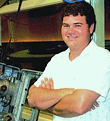|
|
This topic comprises 3 pages: 1 2 3
|
|
Author
|
Topic: My recovery D: drive is almost full, what?!
|
|
|
|
|
|
|
|
|
|
|
|
|
|
|
|
|
|
|
|
|
Leo Enticknap
Film God

Posts: 7474
From: Loma Linda, CA
Registered: Jul 2000
|
 posted 05-11-2008 06:45 AM
posted 05-11-2008 06:45 AM





Just to add something to Chris' explanation. It's possible to divide a single hard drive into two or more separate spaces, which the operating system treats as separate drives, each with their own drive letter. Each space is called a partition. Once a partition is formatted and in use by the computer, the formatted space is called a volume. I'm guessing that Allison has one physical hard drive in her computer, which has been divided up into two spaces (partitions), which have then been formatted as volumes called C: and D:.
Just to be confusing, it's also possible to have two or more physical hard drives in your computer, each of which only has one partition/volume. To see what's what (in either XP or Vista) run start - programs - administrative tools - computer management. You'll need to run it as an administrator (see my post above) if you want to change anything. Once this program is open, click on 'Disk Management'. That will then show you a graphical diagram of all the hard drives in (or connected to) your computer, and how they are partitioned and formatted. By right-clicking on a volume or area of empty space, you can then reformat it, change its drive letter and various other things.
But the short answer to your question is like Chris said. Formatting D: will nuke everything that's on it. There's an area at the start of the volume which contains information about where all the files are physically located on it. Quick formatting deletes the data in this area - it's like tearing the contents page or the index out of a book. Full formatting actually deletes the data itself, replacing it all with zeros. Software does exist which can manually go through the contents of a disc and recover files which are still there but no longer referred to in the 'index' section of a disc.
You only need to do a full format if:
1. There's a security issue - for example if you're about to sell your old computer on Ebay and want to make damn sure that your personal data is all gone from it.
2. If you suspect that there may be an error on the drive, full formatting will also establish whether there is or not (because if there's a physical problem, Windows will give you an error message). For this reason I tend to full format brand new HDDs before using them for the first time, to make sure that if there is a defect on them, I can return them while still under warranty.
3. If you want to change the type of file system for the volume, e.g. change a FAT drive to NTSC.
Otherwise, quick formatting is all you need to do.
| IP: Logged
|
|
|
|
|
|
|
|
|
|
|
|
All times are Central (GMT -6:00)
|
This topic comprises 3 pages: 1 2 3
|
Powered by Infopop Corporation
UBB.classicTM
6.3.1.2
The Film-Tech Forums are designed for various members related to the cinema industry to express their opinions, viewpoints and testimonials on various products, services and events based upon speculation, personal knowledge and factual information through use, therefore all views represented here allow no liability upon the publishers of this web site and the owners of said views assume no liability for any ill will resulting from these postings. The posts made here are for educational as well as entertainment purposes and as such anyone viewing this portion of the website must accept these views as statements of the author of that opinion
and agrees to release the authors from any and all liability.
|

 Home
Home
 Products
Products
 Store
Store
 Forum
Forum
 Warehouse
Warehouse
 Contact Us
Contact Us




 Printer-friendly view of this topic
Printer-friendly view of this topic







![[Wink]](wink.gif) ) and select "Format..." and do a Quick Format. Although being Vista, it might want you to have some elevated admin privileges to do that. Sorry, my Vista experience is still fairly limited.
) and select "Format..." and do a Quick Format. Although being Vista, it might want you to have some elevated admin privileges to do that. Sorry, my Vista experience is still fairly limited.
![[evil]](graemlins/evil.gif) delete VISTA and put in a REAL operating system called XP ..j/k..)
delete VISTA and put in a REAL operating system called XP ..j/k..) 

![[puke]](graemlins/puke.gif) . I run windows 2003. Its basically XP, for servers. 99.9% of the drivers are the same, 99% of XP sofware works on it. Like I said it is an updated XP for servers. Had to have it on my old Mobo, since it was a Dual Xeon serverboard. Wouldn't run non-server OSes. Ran Linux really well too.
. I run windows 2003. Its basically XP, for servers. 99.9% of the drivers are the same, 99% of XP sofware works on it. Like I said it is an updated XP for servers. Had to have it on my old Mobo, since it was a Dual Xeon serverboard. Wouldn't run non-server OSes. Ran Linux really well too. ![[thumbsup]](graemlins/thumbsup.gif) Go SMP.
Go SMP.



![[Smile]](smile.gif)



